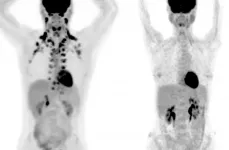(Press-News.org) Brown fat is that magical tissue that you would want more of. Unlike white fat, which stores calories, brown fat burns energy and scientists hope it may hold the key to new obesity treatments. But it has long been unclear whether people with ample brown fat truly enjoy better health. For one thing, it has been hard to even identify such individuals since brown fat is hidden deep inside the body.
Now, a new study in Nature Medicine offers strong evidence: among over 52,000 participants, those who had detectable brown fat were less likely than their peers to suffer cardiac and metabolic conditions ranging from type 2 diabetes to coronary artery disease, which is the leading cause of death in the United States.
The study, by far the largest of its kind in humans, confirms and expands the health benefits of brown fat suggested by previous studies. "For the first time, it reveals a link to lower risk of certain conditions," says Paul Cohen, the Albert Resnick, M.D., Assistant Professor and senior attending physician at The Rockefeller University Hospital. "These findings make us more confident about the potential of targeting brown fat for therapeutic benefit."
A valuable resource
Although brown fat has been studied for decades in newborns and animals, it was only in 2009 that scientists appreciated it can also be also found in some adults, typically around the neck and shoulders. From then on, researchers have scrambled to study the elusive fat cells, which possess the power to burn calories to produce heat in cold conditions.
Large-scale studies of brown fat, however, have been practically impossible because this tissue shows up only on PET scans, a special type of medical imaging. "These scans are expensive, but more importantly, they use radiation," says Tobias Becher, the study's first author and formerly a Clinical Scholar in Cohen's lab. "We don't want to subject many healthy people to that."
A physician-scientist, Becher came up with an alternative. Right across the street from his lab, many thousands of people visit Memorial Sloan Kettering Cancer Center each year to undergo PET scans for cancer evaluation. Becher knew that when radiologists detect brown fat on these scans, they routinely make note of it to make sure it is not mistaken for a tumor. "We realized this could be a valuable resource to get us started with looking at brown fat at a population scale," Becher says.
Protective fat
In collaboration with Heiko Schoder and Andreas Wibmer at Memorial Sloan Kettering, the researchers reviewed 130,000 PET scans from more than 52,000 patients, and found the presence of brown fat in nearly 10 percent of individuals. (Cohen notes that this figure is likely an underestimate because the patients had been instructed to avoid cold exposure, exercise, and caffeine, all of which are thought to increase brown fat activity).
Several common and chronic diseases were less prevalent among people with detectable brown fat. For example, only 4.6 percent had type 2 diabetes, compared with 9.5 percent of people who did not have detectable brown fat. Similarly, 18.9 percent had abnormal cholesterol, compared to 22.2 percent in those without brown fat.
Moreover, the study revealed three more conditions for which people with brown fat have lower risk: hypertension, congestive heart failure, and coronary artery disease--links that had not been observed in previous studies.
Another surprising finding was that brown fat may mitigate the negative health effects of obesity. In general, obese people have increased risk of heart and metabolic conditions; but the researchers found that among obese people who have brown fat, the prevalence of these conditions was similar to that of non-obese people. "It almost seems like they are protected from the harmful effects of white fat," Cohen says.
More than an energy burning powerhouse
The actual mechanisms by which brown fat may contribute to better health are still unclear, but there are some clues. For example, brown-fat cells consume glucose in order to burn calories, and it's possible that this lowers blood glucose levels, a major risk factor for developing diabetes.
The role of brown fat is more mysterious in other conditions like hypertension, which is tightly connected to the hormonal system. "We are considering the possibility that brown fat tissue does more than consume glucose and burn calories, and perhaps actually participates in hormonal signaling to other organs," Cohen says.
The team plans to further study the biology of brown fat, including by looking for genetic variants that may explain why some people have more of it than others--potential first steps toward developing pharmacological ways to stimulate brown fat activity to treat obesity and related conditions.
"The natural question that everybody has is, 'What can I do to get more brown fat?'" Cohen says. "We don't have a good answer to that yet, but it will be an exciting space for scientists to explore in the upcoming years."
INFORMATION:
Amsterdam, NL, January 4, 2021 - The impact of the COVID-19 pandemic on children with disabilities has not received much attention, perhaps because the disease disproportionately affects older individuals. In this special issue of the Journal of Pediatric Rehabilitation Medicine experts assess the impact of the pandemic on pediatric patients with special needs, their caregivers, and healthcare providers. They also focus on the growing importance of telemedicine and provide insights and recommendations for mitigating the impact of the virus in the short and long term.
"Pediatric rehabilitation patients frequently ...
TAMPA, Fla. -- Prostate cancer is one of the most common cancers among men in the U.S. For many patients, hormone therapy is a treatment option. This type of therapy, also called androgen deprivation therapy (ADT), reduces the level of testosterone and other androgens in the body. Lowering androgen levels can make prostate cancer cells grow more slowly or shrink tumors over time. However, patients receiving ADT often experience higher levels of fatigue, depression and cognitive impairment.
Moffitt Cancer Center researchers are investigating whether inflammation ...
PROVIDENCE, R.I. [Brown University] -- Sea ice is a critical indicator of changes in the Earth's climate. A new discovery by Brown University researchers could provide scientists a new way to reconstruct sea ice abundance and distribution information from the ancient past, which could aid in understanding human-induced climate change happening now.
In a study published in Nature Communications, the researchers show that an organic molecule often found in high-latitude ocean sediments, known as tetra-unsaturated alkenone (C37:4), is produced by one or more previously unknown species of ice-dwelling algae. As sea ice concentration ebbs and flows, so do the algae associated with it, as well as the molecules ...
An emerging type of alloy nanoparticle proves more stable, durable than single-element nanoparticles.
Catalysts are integral to countless aspects of modern society. By speeding up important chemical reactions, catalysts support industrial manufacturing and reduce harmful emissions. They also increase efficiency in chemical processes for applications ranging from batteries and transportation to beer and laundry detergent.
As significant as catalysts are, the way they work is often a mystery to scientists. Understanding catalytic processes can help scientists develop more efficient and cost-effective catalysts. In a recent study, scientists from University of Illinois Chicago (UIC) and the U.S. Department of Energy's ...
A team working with Roland Fischer, Professor of Inorganic and Metal-Organic Chemistry at the Technical University Munich (TUM) has developed a highly efficient supercapacitor. The basis of the energy storage device is a novel, powerful and also sustainable graphene hybrid material that has comparable performance data to currently utilized batteries.
Usually, energy storage is associated with batteries and accumulators that provide energy for electronic devices. However, in laptops, cameras, cellphones or vehicles, so-called supercapacitors are increasingly installed these days.
Unlike batteries they can quickly store large amounts of energy and put it out just as fast. ...
Forgive Asiatic black bear if they're not impressed with their popular giant panda neighbors.
For decades, conservationists have preached that panda popularity, and the resulting support for their habitat, automatically benefits other animals in the mountainous ranges. That logic extends across the world, as animals regarded as cute, noble or otherwise appealing drum up support to protect where they live.
Yet in Biological Conservation, scientists take a closer look at how other animals under the panda "umbrella" fare and find several species have every reason to be ticked at panda-centric ...
HOUSTON -- Researchers at The University of Texas MD Anderson Cancer Center have discovered that a protein called NF-kappa B-inducing kinase (NIK) is essential for the shift in metabolic activity that occurs with T cell activation, making it a critical factor in regulating the anti-tumor immune response.
The preclinical research, published today in Nature Immunology, suggests that elevating NIK activity in T cells may be a promising strategy to enhance the effectiveness of immunotherapy, including adoptive cellular therapies and immune checkpoint blockade.
In a preclinical melanoma model, the researchers evaluated melanoma-specific T cells engineered to express higher levels of NIK. Compared to controls, ...
HOUSTON -- Researchers from The University of Texas MD Anderson Cancer Center who profiled more than 45,000 individual cells from patients with peritoneal carcinomatosis (PC), a specific form of metastatic gastric cancer, defined the extensive cellular heterogeneity and identified two distinct subtypes correlated with patient survival.
Based on their findings, published today in Nature Medicine, the researchers developed and validated a gene expression signature capable of predicting patient survival better than other clinical features. If validated in prospective studies, this tool may be useful in stratifying ...
EUGENE, Ore. -- Jan. 4, 2021 -- Phosphorous, calcium and charcoal in spotty patches of fertile soil in the Amazon rainforest suggest that natural processes such as fires and river flooding, not the ingenuity of indigenous populations, created rare sites suitable for agriculture, according to new research.
The presence of pre-Columbian artifacts and signs of plant domestication uncovered in the region's fertile soil, commonly called Amazonian dark earth, had been thought to mean that agricultural practices, including controlled burning, by indigenous people had boosted soil nutrients.
However, radiocarbon dating ...
What The Study Did: Denmark was one of the first countries to enforce lockdown to reduce the spread of COVID-19 and subsequent gradual reopening, whereas Sweden has had few restrictions, largely limited to public recommendations. Researchers assessed public mobility and social media attention associated with COVID-19 spread and societal interventions from February to June in Denmark and Sweden.
Authors: Isabell Brikell, Ph.D., of the Karolinska Institutet in Stockholm, is the corresponding author.
To access the embargoed study: Visit our For The Media website at ...






